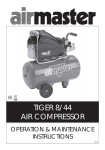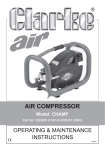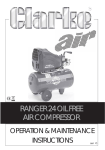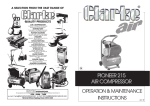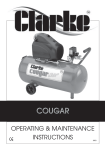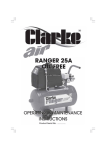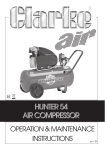Download Clarke PIONEER 220 Operating instructions
Transcript
AIR COMPRESSOR Model No: PIONEER 220 Part Nos: 2320220(230V) & 2320221(110V) OPERATING & MAINTENANCE INSTRUCTIONS GC0511 INTRODUCTION Thank you for purchasing this CLARKE Compressor. Before attempting to operate the machine, it is essential that you read this manual thoroughly and carefully follow all instructions given. In doing so you will ensure the safety of yourself and that of others around you, and you can also look forward to this product giving you long and satisfactory service. GUARANTEE This CLARKE product is guaranteed against faulty manufacture for a period of 12 months from the date of purchase. Please keep your receipt as proof of purchase. This guarantee is invalid if the product is found to have been abused or tampered with in any way, or not used for its intended purpose. Faulty goods should be returned to their place of purchase, no product can be returned to us without prior permission. This guarantee does not effect your statutory rights. ENVIRONMENTAL PROTECTION Do not dispose of this product with general household waste. It must be disposed of according to the laws governing Waste Electrical and Electronic Equipment at a recognised disposal facility. PARTS AND SERVICE For parts & Servicing, please contact your nearest dealer, or CLARKE International, on one of the following numbers. PARTS & SERVICE TEL: 020 8988 7400 PARTS & SERVICE FAX: 020 8558 3622 or e-mail as follows: PARTS: [email protected] SERVICE: [email protected] 2 CONTENTS Introduction ............................................................................................ 2 Guarantee .............................................................................................. 2 Parts & Service ....................................................................................... 2 Technical Specification ......................................................................... 3 General Safety Precautions .................................................................. 4 Electrical Connections .......................................................................... 8 Safety Symbols ....................................................................................... 9 Overview .............................................................................................. 10 Preparation for Use .............................................................................. 11 Operating Instructions ......................................................................... 13 Maintenance ........................................................................................ 16 Troubleshooting .................................................................................... 18 Component Parts ................................................................................. 19 Declaration of Conformity .................................................................. 23 SPECIFICATION Feature Specification Weight 22 kg Dimensions (L x W x H) mm 395 x 320 x 630 Max Operating Pressure 8 Bar / 116 psi Displacement 185 L/min (6.5 cfm) Receiver Capacity 10 litres Duty Cycle S3 - 20% (3 mins in 10) Fuse Rating 13 amps (2320220) Power Supply 230V (2320220) or 110V (2320221) Sound Pressure Level 79 dB LpA Guaranteed Sound Power Level 94 dB LwA Please note that the details and specifications contained herein, are correct at the time of going to print. However, Clarke International reserve the right to change specifications at any time without prior notice. 3 GENERAL SAFETY PRECAUTIONS WORK AREA 1. Keep the work area clean and well lit. Floors should always be kept clear. Cluttered or dark areas invite accidents. 2. Keep children and bystanders away while operating a power tool. Distractions can cause loss of control. 3. The compressor should only be used in areas with adequate ventilation and should not be exposed to heat or used near flammable substances. PERSONAL SAFETY 1. ALWAYS stay alert, watch what you are doing and use common sense when operating the compressor. Do not use the compressor while you are tired or under the influence of medication, drugs or alcohol. A moment of inattention can result in personal injury. 2. ALWAYS use eye protection when operating compressed air equipment, and ensure that others in the work area are protected from flying particles from the front and from the side. 3. ALWAYS protect yourself against electric shock. Never operate the compressor in wet or damp locations. 4. NEVER over-reach. Keep your proper footing and balance at all times to enable better control of the compressor in unexpected situations. 5. NEVER attempt any complex repairs yourself. If you have a technical problem contact your local Clarke dealer. 6. ALWAYS store the compressor out of reach of children. 7. ALWAYS protect your hearing. Ear protection should be worn when operating this compressor and it’s associated power tools. 8. NEVER direct the air stream at people or animals, as injury may result. Compressed air can cause soft tissue damage and propel dirt and other particles at high speed. 9. NEVER touch hot surfaces. During operation, the motor, connections, compressor body, cylinder head and tubes may get hot. Do not touch these until the compressor has cooled down. 10. NEVER insert your fingers or other objects inside the motor housing. Never operate the compressor without the cover in place. GENERAL MACHINE USE AND CARE 1. Prior to use, all operators should become familiar with the instructions in this booklet especially the ON/OFF switch for emergency stopping. 2. ALWAYS maintain the compressor with care and keep it clean for best / safest performance. 4 3. NEVER use this compressor if any part is damaged. Have it inspected and repaired by your Clarke dealer. 4. NEVER attempt to modify the air compressor, tank, fittings or attachments in any way. Doing so will invalidate the guarantee and could result in personal injury. 5. NEVER abuse the power cable. Never pull on the cable when removing the plug from the socket, or lift the compressor by the power cable. 6. ONLY use extension leads that are of an appropriate power rating and suitable for the work environment. Extension leads must have an earth connection. Inspect the extension lead regularly and replace if damaged. 7. ONLY USE RECOMMENDED PARTS: To avoid the risk of bursting, only hoses with a rated pressure of 10 bar, or more should be used. Never attempt to repair damaged hoses. 8. NEVER abuse the compressor by standing on it. AIRLINE HOSES 1. ALWAYS ensure that equipment or power tools used in conjunction with the compressor have a safe working pressure exceeding that of the machine. 2. ALWAYS keep the air hose away from any attached power tools and ensure that the operator is not restricted by the length of the hose. 3. ALWAYS take care when a long air hose is required in the work area as it presents a trip hazard. Coil the hose away as soon as the job is finished. 4. ALWAYS avoid kinking or trapping the air hose. Always replace faulty hoses and never attempt a repair if a leak is detected. 5. NEVER abuse hoses or connectors. NEVER carry an air tool by the hose, or yank it to disconnect from the air supply. Keep hoses away from heat, oil and sharp edges. Check hoses for leaks or worn condition before use and ensure that all connections are secure. 6. ALWAYS ensure that the air supply is turned off at the machine outlet and any air pressure vented from within the compressor and any attached equipment when disconnecting air hoses or other equipment. 5 AIR COMPRESSOR SAFETY INSTRUCTIONS 1. ONLY USE WITHIN THE RECOMMENDED OPERATING TEMPERATURE RANGE: This compressor should only be used in an ambient temperature of between +5OC and +40OC (never at or below freezing temperatures). 2. NEVER USE AN AIR COMPRESSOR WHICH APPEARS DEFECTIVE OR IS OPERATING ABNORMALLY: If the compressor operates unusually or makes strange noises, switch off immediately and purge the air reservoir. Arrange repairs with your nearest Clarke dealer. 3. BREATHING QUALITY AIR: This compressor should not be used to supply breathing quality air. 4. SAFETY VALVE: Never remove or attempt to adjust the safety valve. The maximum pressure is factory set. Keep the safety valve free from paint and other accumulations. 5. AVOID UNINTENTIONAL STARTING: Do not move the compressor when it is connected to the mains power supply. When connecting the compressor to the power supply make sure the red button on top of the control box is in the OFF (down) position. 6. BEFORE EACH USE CHECK THE COMPRESSOR AND HOSE FOR DAMAGED PARTS: Never use the compressor if it has been damaged in any way. Have the compressor repaired by a qualified service engineer. Do not use the compressor if the On/Off switch does not operate correctly. 7. KEEP THE MOTOR AIR VENTS CLEAR: Keep the motor vents clear and free from dust. Wipe regularly to maintain an adequate supply of clean air. Avoid using in dusty conditions. 8. OPERATE THE COMPRESSOR AT THE CORRECT VOLTAGE: Make sure that the mains supply voltage is the same as the voltage shown on the label. 9. DRAIN AIR RESERVOIR: Drain the air reservoir routinely. Switch off and slowly open the drain valve to release the air then tilt the compressor to empty any condensed water. 10. ALWAYS adjust the pressure regulator to the recommended setting for the particular spray gun or air tool being used. 11. WHEN USING THE COMPRESSOR FOR PAINTING: • Do not work in enclosed areas or near naked flames. • Ensure that the area in which you are working has good ventilation. • Protect your nose and mouth with a suitable face mask. • Always check the safety data sheets for substances being sprayed & ensure manufacturer’s instructions are followed. 12. DO NOT USE THIS COMPRESSOR TO INFLATE SMALL, LOW-PRESSURE OBJECTS: Items such as children's toys or footballs can explode if over-inflated. 13. NEVER STOP THE COMPRESSOR BY REMOVING THE PLUG OR SWITCHING OFF AT THE MAINS SUPPLY: Always use the On/Off switch on the compressor. 6 SERVICING & STORAGE 1. TURN OFF THE COMPRESSOR WHEN NOT IN USE: When not in use, turn off the compressor by depressing the On/Off switch, remove the plug from the mains supply. Slowly undo the drain valve to release the pressure from the reservoir. Close the drain valve before storage and ensure it is fully tightened before use. 2. MOVING THE COMPRESSOR: Always transport the compressor by lifting or pulling it with the handle. 3. CLEANLINESS AND CONDITION OF THE COMPRESSOR: Keep the external surfaces of the reservoir clean. Avoid impact damage and do not allow the reservoir to come into contact with abrasive or corrosive materials. 4. DO NOT WIPE THE PLASTIC PARTS WITH SOLVENT: Do not use solvents or thinners such as petrol, benzene, carbon tetrachloride or alcohol to clean the compressor, as these chemicals will damage the finish. With the machine unplugged from the power supply, use a dry cloth to wipe over the plastic casing. 5. STORE THE COMPRESSOR PROPERLY: When not in use the compressor should be stored in a secure, dry place out of the reach of children. Always lock the storage area. DO NOT leave it exposed to the elements and avoid direct sunlight, direct heat, rain/moisture etc. 6. ONLY USE PARTS AND ACCESSORIES RECOMMENDED IN THIS MANUAL: The use of unauthorised accessories or attachments is not permitted and may result in personal injury or damage to the compressor. Do not attempt to repair or modify the compressor. 7 ELECTRICAL CONNECTIONS WARNING! Read these electrical safety instructions thoroughly before connecting the product to the mains supply. Before switching the machine on, ensure that the voltage of your electricity supply is the same as that indicated on the rating plate. These products are designed to operate on either a domestic 230 VAC 50Hz supply (2320220) or an earthed 110VAC 50Hz power supply (2320221). Connecting the compressor to any other power source may cause damage. This product may be fitted with a non-rewireable plug. If it is necessary to change the fuse in the plug, the fuse cover must be refitted. If the fuse cover becomes lost or damaged, the plug must not be used until a suitable replacement is obtained. If the plug has to be changed because it is not suitable for your socket, or due to damage, it should be cut off and a replacement fitted, following the wiring instructions shown below. The old plug must be disposed of safely, as insertion into a mains socket could cause an electrical hazard. WARNING! The wires in the power cable of this product are coloured in accordance with the following code: Blue = Neutral Brown = Live Yellow and Green = Earth If the colours of the wires in the power cable of this product do not correspond with the terminal markings of your plug, proceed as follows. • The wire which is coloured Blue must be connected to the terminal which is marked N or coloured Black. • The wire which is coloured Brown must be connected to the terminal which is marked L or coloured Red. • The wire which is coloured Yellow and Green must be connected to the terminal which is marked E or or coloured Green. Plug must be BS1363/A approved Earth (Green and Yellow) Always fit a 13 Amp fuse. Neutral (Blue) Live (Brown) Ensure that the outer sheath of the cable is firmly held by the clamp 8 We strongly recommend that this machine is connected to the mains supply via a Residual Current Device (RCD). If in doubt, consult a qualified electrician. DO NOT attempt repairs yourself. SAFETY SYMBOLS The following safety symbols are present on the machine: THIS COMPRESSOR SHOULD ALWAYS BE STARTED OR STOPPED BY MEANS OF THE START/STOP BUTTON LOCATED ON THE CONTROL BOX. THIS REDUCES THE RISK OF ACCIDENTAL START-UP. THIS COMPRESSOR SHOULD NEVER BE STOPPED SUDDENLY BY UNPLUGGING FROM THE MAINS SUPPLY. THIS INCREASES THE RISK OF ACCIDENTAL START-UP. NEVER ABUSE THE POWER CABLE RISK OF ELECTRIC SHOCK. THE COMPRESSOR MUST BE DISCONNECTED FROM THE MAINS SUPPLY BEFORE REMOVING ANY COVERS. DO NOT USE IN A DAMP ENVIRONMENT. RISK OF ACCIDENTAL START-UP. THE COMPRESSOR COULD START AUTOMATICALLY IN THE EVENT OF A POWER CUT AND SUBSEQUENT RESET. DO NOT CARRY THE COMPRESSOR WHILE IT IS CONNECTED TO THE POWER SOURCE, OR WHEN THE TANK IS FILLED WITH COMPRESSED AIR. 3 THIS COMPRESSOR INCORPORATES SURFACES WHICH MAY REACH A HIGH TEMPERATURE DURING OPERATION. NEVER OPERATE WITH THE 6 MOTOR COVER REMOVED. 7 THIS COMPRESSOR MAY PRODUCE A HIGH SOUND LEVEL DURING OPERATION. EAR PROTECTION SHOULD BE WORN. 9 READ INSTRUCTIONS BEFORE USE TO REDUCE THE RISK OF INJURY, READ THE MANUAL BEFORE USE. 9 OVERVIEW 10 PREPARATION FOR USE WARNING: Before using the compressor, make sure that you have read and understood the safety instructions. UNPACKING Take care when lifting the compressor from the packaging and obtain assistance if necessary to avoid personal injury or damage to the machine. Always use the handle and frame, with one hand under the tank if required. CAUTION! NEVER TAKE THE WEIGHT OF THE COMPRESSOR BY HOLDING THE PRESSURE CONTROL SWITCH. After removing the compressor from its packaging, check that it has not been damaged in transit. MOVING THE COMPRESSOR When moving the compressor; • Always use the handle. • Do not lift by (or place a strain on) the airline fittings or hoses. • Take care when moving the compressor to avoid damaging the valves or fittings. • Always ensure it is switched off and disconnect from the mains power supply. POSITIONING THE COMPRESSOR This compressor should be positioned on a stable, flat surface. Note: the compressor should not be operated on a steep slope or floor angle of greater than 15O. If the compressor is placed on a shelf or surface raised off the ground, it should be secured appropriately to prevent it from falling off during use. Do not cover or box in the compressor. Always position it with good all-round air ventilation. CONNECTION AND START-UP Before connecting your compressor to the mains supply, check the following:• The correct mains supply voltage is available for the product; either 230V (2320220) or 110V (2320221). 11 • The ON/OFF switch is in the OFF (depressed) position. • The pressure regulator should be set at its lowest setting, i.e. turned fully anticlockwise. (- & + arrows are shown on the knob) • If the compressor has not been used recently, open the drain valve shown in Fig 1 to drain any condensate which may have accumulated. When clear, close the valve, finger tight. Fig 1 IMPORTANT: If the receiver is under pressure, keep your hands well away from the air being expelled. Remember, compressed air is DANGEROUS! WARNING! Before connecting any air tool, make sure you have read and fully understood the manufacturer’s instruction booklet for the air tool being used. Also ensure that the tool is compatible with the compressor and hose specifications. If the pressure rating of the tool is less than 8 bar, the pressure regulator must be used to adjust the output pressure. 1 Connect a suitable air hose to the compressor outlet and the other end to the equipment to be used. Attach the air hose to the outlet connector using the quick-release fitting as shown in Fig 2. 2. Plug in the machine and switch ON at the mains supply. Fig 2 12 CHECKING THE OIL Fig 3 1. Remove dipstick and check the level of oil is between the MAX and MIN marks as shown in Fig 3. If not, top up to the correct level with Clarke SAE40 compressor oil. 2. After the first 5 working hours, replace the oil as described under MAINTENANCE on page 16. OPERATING INSTRUCTIONS STARTING THE COMPRESSOR 1. Pull the ON/OFF switch UP to start the compressor as shown in Fig 4. • The motor should start immediately, and run, while the tank (reservoir) is being pressurised. 2. When starting the compressor for the first time, and before connecting it to the airline equipment, leave it running for about 10 minutes to permit a good distribution of lubricating oil. • Observe that the compressor stops automatically when the maximum pressure of 8 bar is reached. The pressure is indicated on the tank pressure gauge shown in Fig 6. 13 Fig 4 3. Check the operation of the safety valve when under pressure on a daily basis by pulling the ring shown in Fig 5. Air should be released while the ring is pulled out and stop when the ring is released. • If the valve does not operate as described, or if the valve is stuck, it must be replaced by your Clarke dealer before the compressor is used. WARNING: Do not remove or attempt to adjust the safety valve. Fig 5 WORKING PRESSURE ADJUSTMENT Different air tools which can be powered by this compressor will require different operating pressures to work efficiently. Adjust the air pressure delivered using the pressure regulator as follows: 1. Pull the cap of the regulator towards you. 2 Turn the pressure regulator knob clockwise to increase pressure and anticlockwise to decrease pressure. Fig 6 • The pressure setting will be displayed by the outlet pressure gauge shown in Fig 6. 3. Push the regulator cap back to lock it at the set pressure. NORMAL RUNNING The compressor is fitted with a combined ON/OFF pressure switch whose cutin and cut-out pressures are factory set. When the reservoir pressure falls below the minimum threshold setting, (about 2-bar lower than the maximum pressure) the compressor will restart and cut out when the maximum reservoir pressure is achieved. Note: If the machine pumps continuously without intermittently switching on and off, the compressor is too small for the demand of the application/tool being used and damage could result. Consult your Clarke dealer. 14 OVERLOAD CUT-OUT The compressor is fitted with an overload cutout to protect the motor in the event of overheating. If the device should trip out and shut down the compressor, wait around 5 minutes for the machine to cool down before resetting the device by pressing the overload reset button shown in Fig 7. If, having restarted the compressor, the overload cutout trips again, set the main switch to the OFF position, unplug the machine and consult your Clarke dealer. Fig 7 SHUTTING DOWN AND STORAGE 1. Press the red ON/OFF switch to shut off the compressor. • Never stop the compressor by unplugging it from the power supply. It should be turned off as above. 2. After use, set the outlet pressure back to zero. 3. Operate the trigger of all equipment (tools, spray gun etc.) to release any air pressure from the hose before disconnecting the hose from the compressor. Before transporting or storing the compressor, always release the air pressure from the reservoir by opening the drain valve shown in Fig 1. • It may be desirable to place a container beneath the compressor to catch any condensate. Note: If conditions are below freezing, it is advisable to store air tools in a warmer place. Remember, the compressor should not be operated at very low ambient temperatures. 15 MAINTENANCE WARNING: Always vent the receiver tank before carrying out any adjustments, servicing or maintenance. Never unscrew a connection whilst the air receiver is Under pressure. Always ensure the receiver has been vented. DAILY / WEEKLY / BEFORE USE 1. Drain any condensate by opening the drain valve located under the receiver. As soon as air starts to flow out, close the drain cock. 2. Inspect the compressor for damaged parts or for any loose screws or bolts. 3. Check the oil level is between the MAX & MIN marks on the dipstick & top up if necessary. (Use Clarke SAE40 compressor oil). Ensure the oil does not drop below the minimum level to avoid damage to the compressor. PERIODICALLY 1. Check the sponge air inlet filter element shown in Fig 8 for cleanliness. If necessary, it may be gently washed in warm soapy water. Rinse and allow to dry thoroughly before refitting. Fig 8 This should be done more frequently if the compressor operates in a very dusty area.) CAUTION: NEVER OPERATE THE COMPRESSOR WITHOUT THE SPONGE FILTER, AS FOREIGN MATTER COULD SERIOUSLY DAMAGE THE INTERNAL COMPONENTS. IF DAMAGED, THE FILTER SHOULD BE REPLACED. 2. Keep the cooling fins clear of dust if the machine is being used in a dirty workplace. 6 MONTHLY/500 HOURS If the oil has become contaminated it should be replaced as follows; 1. Remove the dipstick and unscrew the drain plug from the crankcase cover as shown in Fig 9 and drain the oil into a container. Note: This operation is best performed when the machine is warm so as to encourage the oil to drain easily. 2. Replace the drain plug and refill with fresh oil up to the MAX level on the dipstick. 16 CAUTION: PROLONGED EXPOSURE TO USED OIL IS DANGEROUS, ALWAYS WASH YOUR HANDS THOROUGHLY AFTER HANDLING USED OIL. RECOMMENDED OILS Any compressor oil can be used which is suitable for use at room temperatures from + 5OC to + 45OC. Clarke SAE40 Compressor Oil (1 litre) is available from your Clarke dealer (Part no: 3050810). See the Clarke Catalogue for other consumables. Fig 9 ENVIRONMENTAL PROTECTION One of the most damaging sources of environmental pollution is oil. Do not throw away used oil with domestic refuse or flush down a sink or drain. Collect old oil in a leakproof container and take it to your local waste disposal site. EVERY 2 YEARS Check the non-return valve and if necessary, replace the gasket (O-ring) shown in Fig 11. IMPORTANT: The use of parts other than Clarke replacement parts may result in safety hazards, poor performance and will invalidate your warranty. Your Clarke compressor has been designed to give long and trouble free service. If, however, having followed the instructions in this booklet carefully, you encounter problems, take the unit to your local Clarke dealer. Fig 10 ACCESSORIES & CONSUMABLES A wide range of airline accessories is available, including Filter/Regulators. Lubricators, High Pressure Hoses, Whip Hose etc. Contact your Clarke dealer for further information. Fig 11 The use of parts other than genuine Clarke replacement parts may result in safety hazards, decreased machine performance, and will invalidate your warranty. 17 TROUBLESHOOTING SYMPTOM PROBLEM SOLUTION Pressure drop in the receiver. Air leaks at connections. Compressor stops and will not start again. Bad electrical connections. Check electrical connections. Blown fuse. Clean and tighten as necessary Overload cut-out switch Renew/replace fuse. has tripped. Switch off the machine and wait 5 minutes before pressing reset button. Compressor fails to reach the set pressure and overheats easily. Compressor head gasket failed or valve damaged. Stop the compressor and contact your Clarke dealer. Compressor does not start. Air reservoir already charged. Open drain cock to expel air. Compressor should start again when the stored pressure reaches the setting of the pressure control switch (approx 95 psi). Air found leaking from the pressure switch valve when the compressor is not running. Faulty non-return valve. Vent the air receiver completely of air. Remove the valve end plug, carefully clean the valve end seat and gasket, then re-assemble. See Fig 10. Pressure switch valve leaks after the compressor has been running for more than about a minute. Failure of the empty-start valve in the pressure control switch. Replace the control switch. Air pressure cannot be adjusted at the regulator. Broken diaphragm inside the regulator body. Replace regulator. Compressor keeps running Incorrect operation of the after the maximum pressure pressure control switch. has been reached, causing the safety valve to be activated. Compressor making undue mechanical noise. Compressor will not run. Run the compressor to create maximum pressure. Switch it off and brush a soapy water solution onto all connections. Look carefully for air bubbles being forced out. T ighten any connections where bubbles are seen. If problem persists, contact your Clarke dealer. Contact your Clarke dealer. Compressor is damaged and requires overhaul. Stop using and contact your Clarke dealer. Motor winding burnt out. Contact your Clarke dealer 18 In the event that any of the above situations arises, requiring the dismantling and overhaul of the compressor, contact your Clarke International Service Department on 020-8988-7400. COMPONENT PARTS - RECEIVER & CONTROLS No Description Part No Qty No Description Part No Qty 1 RESERVOIR (TANK) FN164120001V 1 16 1/4" PLUG FN111001000 1 2 1/2" PLUG FN111008000 1 17 SAFETY VALVE FN047220000 1 3 VIBRATION DAMPER FN020186000 2 18 STRAIGHT FITTING FNB60505000 1 4 WHEEL SPINDLE FN168HQ0004 2 19 'RILSAN' TUBE (8X10) FN046003000 1 5 WHEEL FN020188000 2 20 L-FITTING 1/4" x 10 FN011751000 1 PRESSURE GAUGE FN330006000 2 6 NON-RETURN VALVE FN347092000 1 21 7 GASKET FNF99357000 1 22 QUICK-FIT COUPLING FN322007000 1 8 SPRING FN04711302 1 23 1/4" PLUG FN011364000 2 9 SEAL FN047129002 1 24 MANIFOLD FN125HO0011 1 10 L-FITTING 1/8" x 6 FN011055000 1 25 HANDLE FN116022015 1 11 'RILSAN' TUBE (6X4) FN046001000 1 26 NOSE CONE FN161535012 1 12 DELIVERY PIPE FN164IQ0001 1 27 RING NUT FN116HP0011 1 13 NIPPLE FN011017000 1 28 BASEPLATE FN1681Q0005V 1 14 PRESSURE SWITCH FN321028000 1 29 DRAINCOCK FN0220085000 1 15 POWER CABLE (110V) FN172PO5200 POWER CABLE (230V) FN101GA0200 1 1 19 PARTS DIAGRAM - AIR RECEIVER & CONTROLS 20 PARTS DIAGRAM - COMPRESSOR 21 COMPONENT PARTS - COMPRESSOR No Description Part No Qty No Description Part No Qty 1 DIPSTICK ASSEMBLY FN312043000 1 23 ROTOR FN116HT0004 1 2 OIL DIPSTICK FN012043000 1 24 SEAL RING FN010132000 1 3 O-RING FN010024000 1 25 BEARING FN033082000 1 4 O-RING FN010072000 1 26 OVERLOAD CUTOUT FN008262000 1 5 SCREW FN014013024 1 27 LOCK-WASHER FN014008006 1 6 SCREW FN014006024 4 28 SELF-TAPPING SCREW FN014013000 1 7 FRONT COVER FN016120003 1 29 O-RING FN010133000 1 8 COVER GASKET FN116120030 1 30 SCREW FN014001071 2 9 CRANKSHAFT FN116120023 1 31 HEAD FN116120015 1 10 CRANKCASE FN116120006 1 32 SCREW FN014002026 2 11 NUT FN161190010 3 33 HEAD GASKET FN116120014 1 12 NUT FN014003018 2 34 VALVE PLATE FN116120100 1 13 CAPACITOR FN009200004 1 35 CONNECTING ROD FN116091021 1 14 LOCK WASHER FN014008020 3 36 CYLINDER FN116HT0001 1 15 SCREW FN014013086 3 37 PISTON RING SET FN216022002 1 16 CIRCLIP FN015083000 1 38 PISTON FN116022004 1 17 FILTER ELEMENT FN116120017 1 39 GUDGEON PIN FN116022040 1 18 SHROUD FN116120001 1 40 CIRCLIP FN015001000 2 19 FAN FN116120008 1 41 COMPLETE PISTON FN416022004 1 20 REAR COVER FN116120007 1 42 BEARING FN033118000 1 GASKET SET (110V) FN216120006 1 GASKET SET (320V) FN216120004 1 21 22 CYL. GASKET( 110V) FN116120022 1 CYL. GASKET (230V) FN116HT0002 1 STATOR (230V) FN316120604 1 STATOR (110V) FN316120601 1 43 22 DECLARATION OF CONFORMITY 23
























